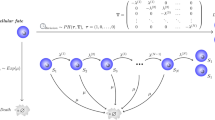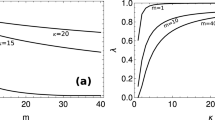Abstract
SEVERAL proposals have been advanced to explain how cell cycle duration (and hence proliferation rates) is governed1–3. It is important to establish which (if any) of these models is correct as they imply differing biological mechanisms of cell-cycle control. The transition probability hypothesis divides the cell cycle into two phases A and B, the transition from A to B occurring at random3. As a consequence a graph of the logarithm of the percentage of undivided cells (αt) against time after mitosis (the α curve) shows two components since αt will be 100% for times up to the minimum cycle time TB (the duration of B phase) and decay exponentially thereafter. This model has been criticised on the grounds that other models of the cell cycle can generate similar α curves and on the basis of the α curve it is difficult to tell these models apart4. In what follows the exponential nature of the distribution of differences of sister cell cycle times (the β curve) is shown to be a unique property of cell cycle models containing an exponentially distributed phase.
This is a preview of subscription content, access via your institution
Access options
Subscribe to this journal
Receive 51 print issues and online access
$199.00 per year
only $3.90 per issue
Buy this article
- Purchase on Springer Link
- Instant access to full article PDF
Prices may be subject to local taxes which are calculated during checkout
Similar content being viewed by others
References
Kubitschek, H. E. Expl cell. Res. 26, 439–450 (1962).
Schmid, P. Expl cell. Res. 45, 471–486 (1967).
Smith, J. A. & Martin, L. Proc. natn. Acad. Sci. U.S.A. 70, 1263–1267 (1973).
Wheals, A. E. Nature 267, 647 (1977).
Minor, P. D. & Smith, J. A. Nature 248, 241–243 (1974).
Shields, R. & Smith, J. A. J. cell. Physiol. 91, 345–356 (1977).
Shields, R. Nature 267, 704–707 (1977).
Smith, J. A. & Martin, L. in Cell Cycle Controls (eds Padilla, G. M., Cameron, I. L. & Zimmerman, A.) 43–60 (Academic, New York, 1974).
Thompson, L. H. & Suit, H. D. Int. J. Radiat. Biol. 15, 347–362 (1969).
Author information
Authors and Affiliations
Rights and permissions
About this article
Cite this article
SHIELDS, R. Further evidence for a random transition in the cell cycle. Nature 273, 755–758 (1978). https://doi.org/10.1038/273755a0
Received:
Accepted:
Issue Date:
DOI: https://doi.org/10.1038/273755a0
This article is cited by
-
Analysis of cell proliferation in Drosophila wing imaginal discs using mosaic clones
Heredity (2004)
-
Cell growth and division: a deterministic/probabilistic model of the cell cycle
Journal of Mathematical Biology (1986)
-
Globally asymptotic properties of proliferating cell populations
Journal of Mathematical Biology (1984)
-
Recent views on the cell cycle structure
Bulletin of Mathematical Biology (1983)
-
Limitations of cell kinetics in distinguishing cell cycle models
Nature (1981)
Comments
By submitting a comment you agree to abide by our Terms and Community Guidelines. If you find something abusive or that does not comply with our terms or guidelines please flag it as inappropriate.



